Mi SciELO
Servicios Personalizados
Articulo
Indicadores
-
 Citado por SciELO
Citado por SciELO
Links relacionados
-
 Similares en
SciELO
Similares en
SciELO
Compartir
Humanidades Médicas
versión On-line ISSN 1727-8120
Rev Hum Med v.9 n.2 Ciudad de Camaguey Mayo-ago. 2009
CÁTEDRA
Curso introductorio de Inglés con Fines Médicos
Introductory course of English for Medical Purposes
María Josefa Moré Peláez, (I) Isabel Pérez Ortiz, (II) Concepción Bueno Velazco (III)
(I) Licenciada en Educación, especialidad Inglés. Máster. Profesora Auxiliar. Instituto Superior de Ciencias Médicas “Carlos J. Finlay” Camagüey. Carretera Central Oeste, CP 70100, AP 144. E-mail: mjmp@iscmc.cmw.sld.cu
(II) Licenciada en Educación, especialidad. Inglés. Profesora Instructor. Instituto Superior de Ciencias Médicas “Carlos J. Finlay” Camagüey. Carretera Central Oeste, CP 70100, AP 144. E-mail: iportiz@finlay.cmw.sld.cu
(III) Licenciada en Educación, especialidad. Inglés. Máster. Profesora Titular. Instituto Superior de Ciencias Médicas “Carlos J. Finlay” Camagüey. Carretera Central Oeste, CP 70100, AP 144. E-mail: cvbueno@iscmc.cmw.sld.cu
RESUMEN
ABSTRACT
INTRODUCCIÓN
A continuación se ofrece una reseña breve de los elementos esenciales que conforman el contenido de cada una de las tareas de este curso introductorio.
| Tarea | Contenido |
| 1 | Introduce terminología básica relativa a enfermedades, partes del cuerpo, signos y síntomas y permite la contextualización de los términos según el campo semántico correspondiente, en tanto aporta elementos culturales y estimula los procesos lógicos del pensamiento crítico. |
| 2 | Presenta vocabulario esencial para la descripción anatómica de las partes del cuerpo, y practica la sub-habilidad de formular definiciones de términos clave, e inferir significado de vocablos y frases a partir de definiciones dadas. |
| 3 | Ofrece un contexto comunicativo que facilita el desarrollo de la fluidez a partir del reforzamiento de la sub-habilidad de definir y enunciar conceptos breves e integra habilidades como la lectura, escritura, audición y expresión oral. |
| 4 | Centra su objetivo en el desarrollo del vocabulario relativo a las especialidades y los especialistas e introduce esenciales básicos para la formación de palabras de origen latín y griego. |
| 5 | Conduce al desarrollo de la competencia lingüística y la conciencia gramatical respecto al uso del artículo definido y sus especificidades en el uso del lenguaje médico. |
| 6 | Introduce terminología específica de la anatomía de un hospital y hace uso del enfoque de aprendizaje en espiral a partir de la revisión y ampliación de conocimientos lingüísticos previos. Incluye ejercicios de simulación y motiva el desarrollo de la fluidez en la habilidad de escritura. |
| 7 | Permite familiarizar al cursista con el lenguaje del la consulta médica y el manejo del paciente. Practica las habilidades de leer con propósitos específicos, inferir, resumir, escanear ideas e incorpora técnicas de aprendizaje grupal. |
| 8 | Ofrece una segunda visión al fenómeno gramatical y sus especificidades en la práctica médica, permite reforzar la relación función-forma-significado, elementos claves en el tratamiento de la gramática comunicativa. |
| 9 | Aporta un entorno socio-lingüístico que hace factible la consolidación, sistematización e integración de las habilidades desarrolladas durante el curso, permite la utilización de materiales auténticos, estimula a la creatividad y la aplicación consciente de los conocimientos adquiridos. |
ANEXOS
Anexo 1. Introduction to English for Medicine: Student’s Book
A continuación se presenta sólo una muestra del Curso Introductorio al Inglés Médico. En un primer bloque aparecen algunas de las tareas pero no se sigue un orden secuencial en las mismas; sólo se presentan algunas a modo de ejemplo.
 |  |
Task 1 Look at this passage. It goes back to the origin of the term medicine. Medicine is taken almost directly from the Latin medicina, which to the Romans, meant almost the same as “medicine” means to us. This word, in turn, is related to mediri, “to heal”. Both in ancient times and now, the same word _ medicina or “medicine”_ serves for both to the science of healing and to the means of healing, i.e., what we also call “drugs”. (iii) A more up-to-date and comprehensive view of the term sees medicine as the science and art of dealing with the maintenance of health and the prevention, alleviation or cure of disease. a) Read the passage carefully and be ready to discuss about your personal motivation, driving forces, inspiration and/or enthusiasm in relation to your medical studies, then write your own definition of the word medicine. b) The words listed below are all connected in some way to the meaning of the term medicine. Read carefully and arrange them into any of the following word sets: Fever Heart Hypertension Cardiovascular Respiratory Pneumonia Gastrointestinal Lungs Appendicitis Abdomen Pain Headache
| Disease | Symptoms & signs | Body parts | Body systems |
c) Can you add any other words to each group? d) What about disease? What synonyms or near synonyms could be used to designate this category?
Task 2 Look at the following diagrams showing the outer structure of a human body (on the left) divided into three main parts; the head, the trunk and the upper and lower extremities and some internal organs (on the right). a) In groups study the diagrams, match the words below to the numbers in the pictures, then, write the correct words for numbers 16 to 30 and then practice saying these words as your teacher provides you with a pronunciation model. ___ shoulder ___ thigh ___ wrist ___ forearm ___ kidney ___ heel ___ navel ___ elbow ___ liver ___ sphincter muscle ___ calf ___ esophagus ___ chest ___ bladder ___ nipple
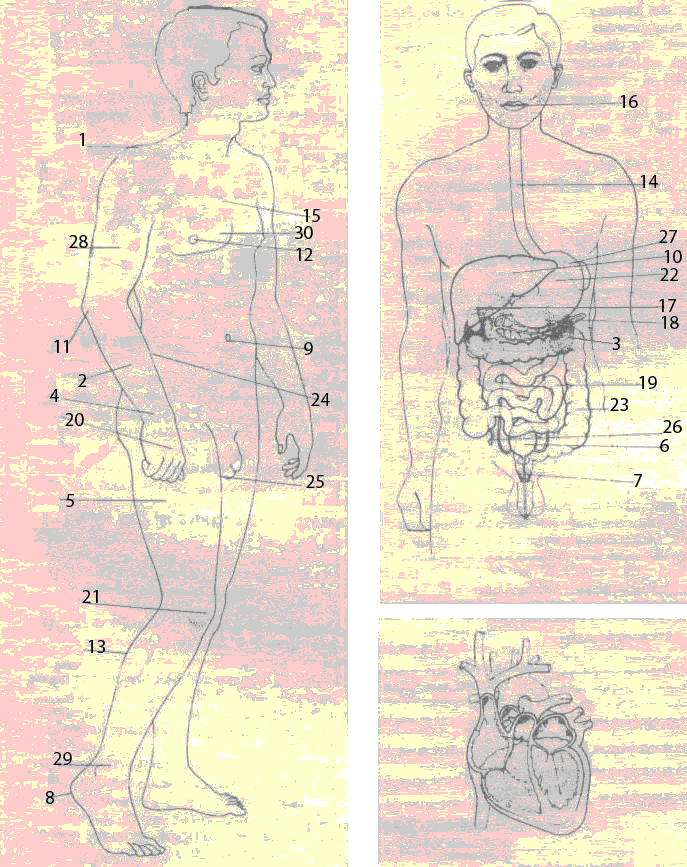
16.____________ 17.____________ 18. ____________ 19. ____________ 20. ____________ 21.____________ 22. ____________ 23. ____________ 24. ____________ 25.____________ 26. ____________ 27. ____________ 28. ____________ 29. ____________ 30. ____________ ? Notice that the definite article the is always used for body parts and organs. e.g. the spleen. b) Work in pairs. Guess what part of the body or body organ is being defined. 1. The paired organs in the lumbar region. They are bean-shaped. They regulate the normal concentrations of the constituents of the blood._______________ 2. The part of the upper limb between the arm and forearm. _______________ 3. The region of the junction of the arm and the trunk. _______________ 4. The part that extends from the hip to the toes._______________ 5. The part that connects the head with the trunk._______________ 6. Any of the digits of the hand._______________ 7. The largest gland of the body, occupying the upper part of the abdomen especially on the right side. It is the central organ of metabolism of carbohydrate, proteins and fat._______________ 8. The muscular organ, which keeps the circulation of the blood by its pumping action._______________ 9. The paired organs of respiration, situated at each side of the mediastinum._______________ c) Write definitions for any two other parts of the human body. d) The words listed in column A are very much used when doctors need to explain some of these parts or compounds. Could you match them?
Task 4 For the study of the different parts of the body and body systems, a wide range of specialties have been identified.
a) Look at the following word list. There are some words hidden on both sides. Could you help to find them?
| Specialties | Specialists |
| 1. physiology 2. ___________
3. cardiology 4. ___________
5. surgery 6. nephrology 7. gynecology 8. bacteriology 9. ___________ 10. epidemiology 11. ___________ 12. oncology 13. obstetrics 14. ___________ | physiologist neurologist __________ hematologist surgeon __________ gynecologist __________ dermatologist __________ otorhinolaryngologist (iv) __________ obstetrician pediatrician |
e) The word cardiology means the study of the heart, its actions and diseases. This term is formed by the combination of cardi (which comes from the Greek kardi = heart) and logy which means the study of or the science of. The following exercise provides you with some other major roots, prefixes and suffixes from which medical lexis is formed. Study the two columns and match them accordingly.
| A | B |
| 1. hepat 2. derm 3. glyc 4. osteo 5. nephr 6. bio 7. hypo 8. itis 9. gast 10. gram | ____ life ____ bone ____ below, insufficient ____ stomach ____ liver ____ mechanical recording ____ inflammation ____ skin ____ sugar ____ kidney |
? In the previous tasks you may probably have noticed that we use the or a/an indistinctively or may not even use them at all. Grammatically speaking, when do we use one or the other? When not? We use the (1) when we are thinking of one particular thing e.g. The patient sat on the chair nearest the door (2) when it is clear in the situation which thing or person we mean e.g. Can you turn off the endoscope (= the one in this room) (3) when there is only one of something e.g. I’d like to speak to the doctor in charge. In Medical English, however, these rules are made easier if you:
DO NOT USE the with diseases and symptoms e.g. cancer, vomiting, etc.
with substances e.g. agar-agar, carbon dioxide, etc. with subject fields e.g. oncology, biochemistry, etc. when referring to groups in general e.g. patients, men, etc.DO USE the with parts of the body e.g. the head, the spleen, etc.
when referring to something specific e.g. something already mentioned. ? Notice that we do not use the with subject fields, e.g. Radiology applies to both diagnostic and therapeutic studies, but we use a/an when referring to a specialist, e.g. He is an orthopedic surgeon. (We use a/an to say what kind of thing or person something/somebody is) You cannot use singular countable nouns alone (without a/the/my etc.) e.g., I have a headache/a stomach-ache.Task 5 As you have seen the/a/an are troublesome areas in medical language. Work in pairs and fill in the blanks only when necessary. 1. As a child he had had ____ scarlet fever and ____ varicella 2. It’s important to immunize ____ children before the age of 5. 3. He works in ____ Faculty of ____ Medicine. 4. The patient presented with pain in ____ left arm. 5. Would you like to be ____ obstetrician? 6. I don’t feel very well this morning. I’ve got ____ sore throat. 7. He couldn’t decide whether to specialize in ____ Pediatrics or in Anesthesiology. 8. All patients received ____ Amoxicillin 250 mg 6 hourly. 9. The drug was found to cause ____ nausea. 10. It’s stated that ____women live longer than men. Task 6 a) The chart presented below describes the anatomy of a Hospital. The structure is arranged according to different fields of specialization. As you can see some important services have been whited out. Work with a partner and using the words from the list below insert them into the heading they belong in. Then listen to the pronunciation of these words and practice saying them with your partner.
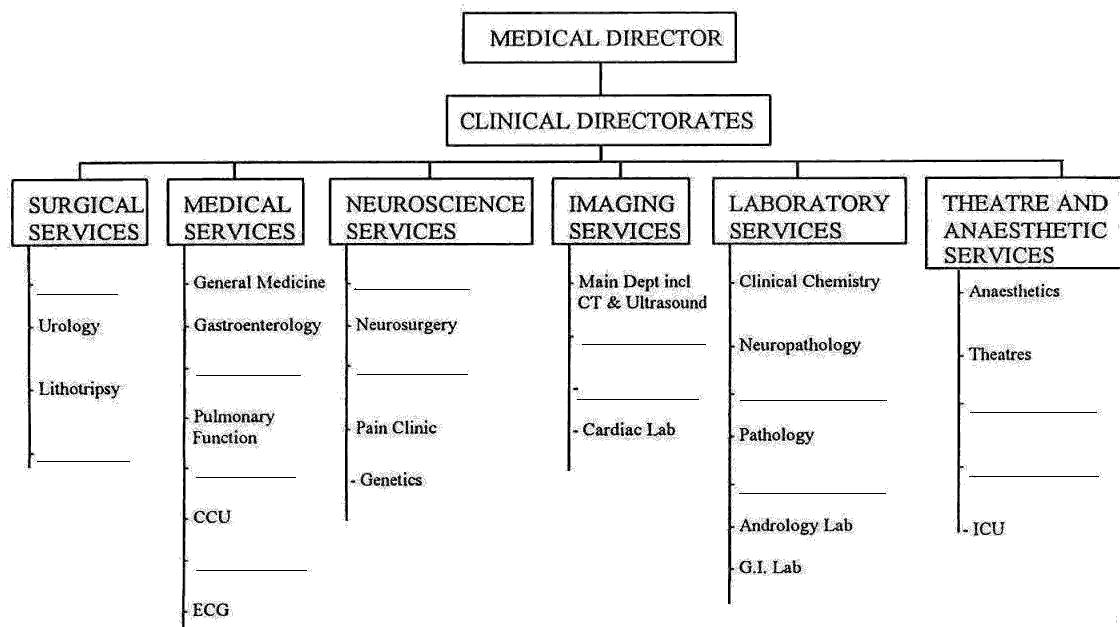
Rheumatology – X-ray –Respiratory – Cardiology – General surgery – Recovery room – Neurology Microbiology – Diagnostic radiology – Hematology – Neuro OPD – Breast services – Sterile services
b) Is there any difference between the model structure presented and the hospitals you are familiar with? Support your answers. c) Now you are members of a planning committee for an international conference that is going to be held at your hospital. During the conference, participants will need information about the services available in or near the conference centre. Work in pairs, choose one of the services above and produce a brief description for conference participants in a small paragraph. Be ready to share your ideas in plenary. Task 9 Another important stage of the medical consultation in which doctors also need to deal with language connected to medications is management. Some useful terms include the notions of containers, modes of presentation, purpose, uses, directions and adverse reactions. a) This activity will allow you to learn some practical vocabulary associated with two of these; containers and modes of presentation. With the help of your teacher and the visual support provided in the picture supply the words missing in both diagrams.
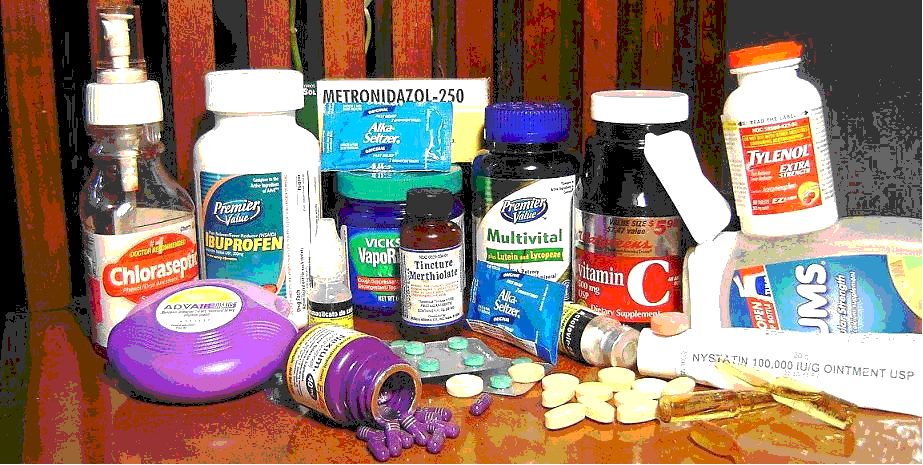

b) Use the words in the diagram to complete these sentences. Then compare with a partner. You may use each word more than once. 1. A bottle of Ibuprofen ___________ 2. A/an ___________ of Nistatine ointment. 3. A bottle of Merthiolate ___________ 4. A/an ___________ of inhalation powder. 5. A blister of Amoxicillin ___________ 6. A/an _________ of Vick’s Vaporub. 7. A/an _________ of Penicillin. c) These are all warning statements taken from different medicine labels. Choose the correct preposition to complete the ideas. Then be ready to discuss your answers in plenary. 1. Do not use __________ (by - for) mouth. 2. Avoid contact _________ (in - with) eyes. 3. It is important not to use this medication __________ (for - during) the last three months of pregnancy. 4. Take 1 tablet every 4 to 6 hours __________ (while- during) symptoms persist. 5. Apply __________ (with – to) minor cuts and scratches 1 to 3 times a day. 6. It may interact _________ (in – with) certain prescriptions. 7. Do not use the maximum dosage __________ (for- since) more than 2 weeks. d) Work in groups, study the notes below, then read the information labeled in the materials provided by your teacher and prepare a brief talk about it. Try to include everything you consider necessary for an accurate understanding of its purposes, uses, directions and adverse reactions. e.g. ? Purpose: antacid, dietary supplement. ? Uses: relieves heartburn and sour stomach, helps promote healthy immune function and general well-being. ? Directions: chew 2-4 tablets as symptoms occur, one tablet daily preferably with a meal. ? Adverse reactions: do not take more than…, … may interact with certain prescription drugs. Anexo 2: Introduction to English for Medicine: Teacher’s Book Este anexo brinda las orientaciones metodológicas y de contenido de las tareas docentes que se ejemplifican en el Anexo 1, con sus respectivas claves de respuestas aunque se refleja el plan temático de la unidad en toda su extensión. En todos los casos el profesor hará uso de estas orientaciones según estime conveniente atendiendo a las características de su grupo de estudiantes y del nivel en que se imparta el curso.
UNIT PLAN
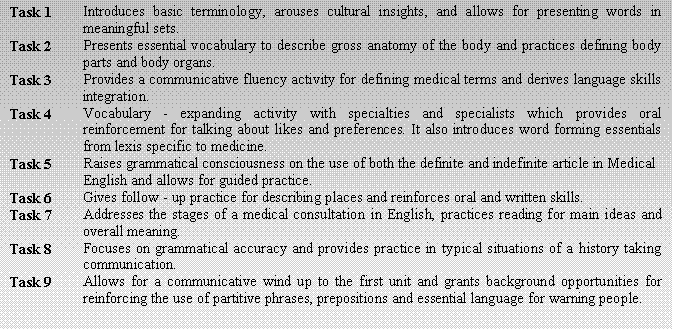
Task 1 a) Introduce the students to the theme of the course book before they look at it. Use the information in the box to enhance the students’ cultural background. If necessary explain the meaning of the word heal. If the class shows any difficulty with the meaning of the word health, you may provide associations with the opposite term (disease). This can be done by the whole class, groups, pairs or individuals. Invite the students to share their answers in plenary. Write on the BB the best definitions they may come up with. Answer key Accept any logical and linguistically correct answer. b) Brief the students on what has to be done before allowing them to attempt the activity. Model the pronunciation of the words in the list. You may provide further examples if necessary. Check the students’ answers by raising awareness on the connections that may be established among the items provided. (notice how the items are arranged within the answer key chart)
Answer key
| Disease | Symptoms & signs | Body parts | Body systems |
| Hypertension | Headache | Heart | Cardiovascular |
| Pneumonia | Fever | Lungs | Respiratory |
| Appendicitis | Pain | Abdomen | Gastrointestinal |
c) Allow the class to add any other correct word they may come up with. Answer key Any word denoting either of the categories included in the box.
d) Go back to the four categories presented in a) and focus on the term disease = a disorder with a specific cause and recognizable signs and symptoms, any body abnormality or failure to function properly. In the mind of people a serious problem). Then, invite the class to brainstorm on useful language associated to the word disease. Elicit vocabulary from the class as a whole and write it up on the BB. Answer key Answers may include the following: ? illness, sickness: poor health ? ailment: not serious illness, e.g. a cold ? dysfunction: a state of abnormal, incomplete or impaired function of an organ e.g. sexual ? disorder: a state of the body or mind when something is not working properly e.g. mental, stomach, etc. ? failure: applied with reference to bodily organs, systems or processes when their function fails, e.g. heart, renal, metabolic, etc. ? impairment: an identifiable structural handicap, which may be unsuspected by the individual and discovered by clinical observation or testing, e.g. hearing, renal. etc. ? syndrome: a group of signs and symptoms that occur together and characterize a particular abnormality, e.g. Acquired immunodeficiency syndrome, Cushing’s, etc. ? malady: disease, disorder, infirmity, affection, ailment, condition. ? affection: a bodily condition, disease, malady. ? infirmity: the quality or state of being infirm (poor or deteriorated vitality).
Task 2 This exercise presents vocabulary needed to describe parts of the body and gross anatomy of the trunk. a) Introduce and model the pronunciation of the words in the list. Get the class to work in pairs and match the 15 words given with the numbers on the pictures. Then ask the class to write down the words for numbers16 to 30 .They can use a dictionary. Check students’ answers.
Answer key (v)
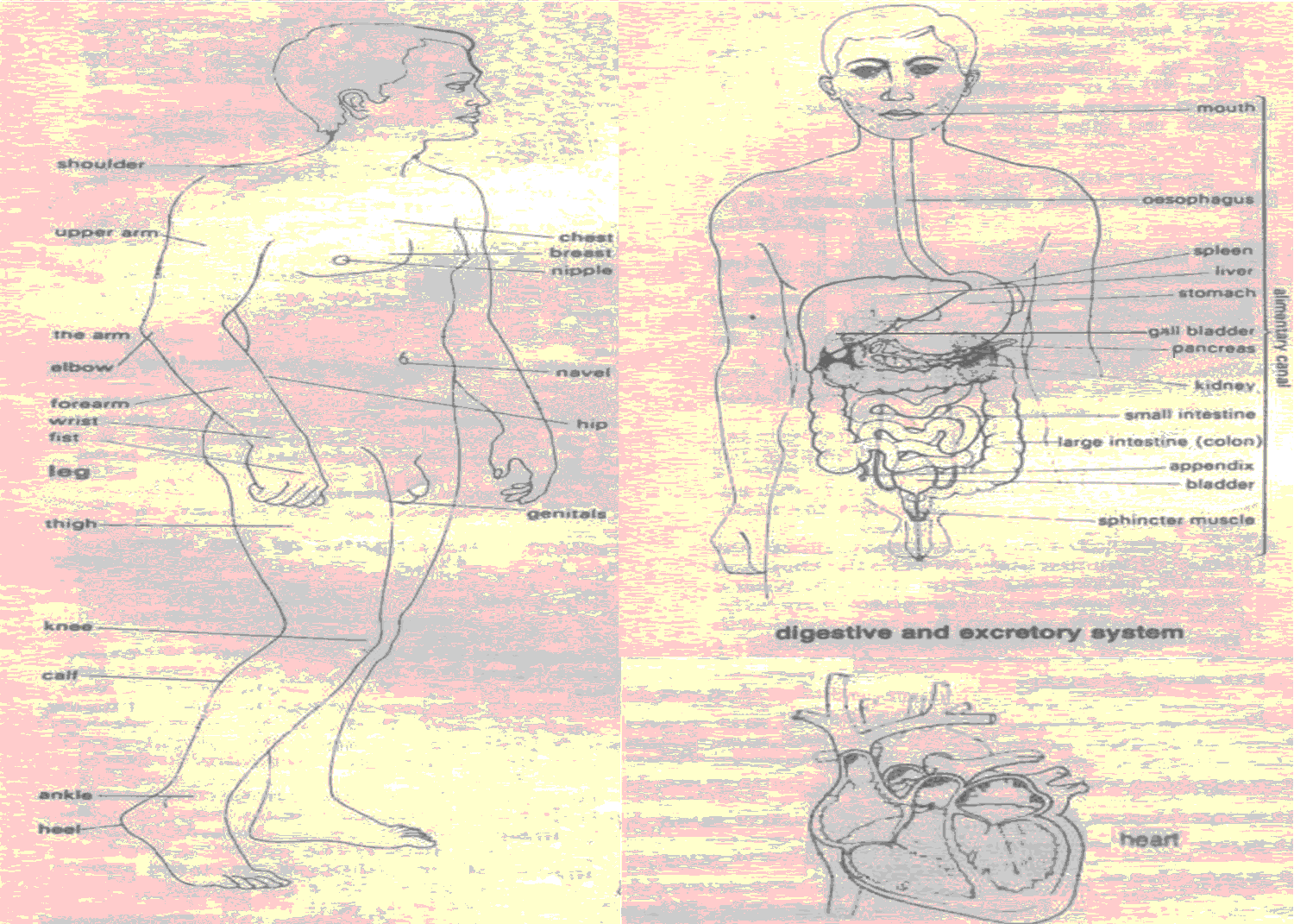
Task 4 This is a vocabulary building exercise with words organized into a semantic set, so that not only can the meanings of the words be more effectively learned in such set, but because they can be remembered better. It also presents some major roots, prefixes and suffixes from which medical lexis is formed. Explain the task by asking students to find the words hidden in both columns. Teach the term General Practitioner GP or Generalist, used for those whose practice is not limited to a specialty. a) As students do the task, go around the class and give help as needed. Check students’ answers. Model the pronunciation of the words in the lists. Students repeat.
Answer key
| Specialties | Specialists |
| Neurology | Cardiologist |
| Hematology | Nephrologist |
| Dermatology | Bacteriologist |
| Otorhinolaringology | Epidemiologist |
| Pediatrics | Oncologist |
Task 5 This is the first formally explicit grammar section. It is mostly designed to be looked at and studied in silence. At this point of the unit students must be made aware of certain simple rules for the use of the article and some basic regularities of use in Medical English which might be of great help. You may either get the class to study and analyze the grammar notes on their own, go through them together with the class, or use them for feedback work as required.
Answer key 1. As a child he had had _X_ scarlet fever and _X_ varicella 2. It’s important to immunize _X_ children before the age of 5. 3. He works in the Faculty of _X_ Medicine. 4. The patient presented with pain in the left arm. 5. Would you like to be an obstetrician? 6. I don’t feel very well this morning. I’ve got a sore throat. 7. He couldn’t decide whether to specialize in _X_ Pediatrics or in Anesthesiology. 8. All patients received _X_ amoxicillin 250 mg 6 hourly. 9. The drug was found to cause _X_ nausea. 10. Statistics show that _X_ women live longer than men.
Task 6 This exercise presents language to describe the anatomy of a hospital and allows for reviewing the structure “It’s a place where you…” and reinforcing the causative use of have and get. a) Explain the task. Model the pronunciation of the words in the list. Pre-teach the abbreviation for outpatient department (OPD). Students match the words with the type of service they belong in. Explain the meanings of the abbreviations CCU (cardiac/coronary care unit), ECG/EKG (electrocardiogram), CT (computerized tomography), GI (gastrointestinal), ICU (intensive care unit). You may also explain the term andrology = the study of male infertility and impotence. The study of androgen production and the relationship of plasma androgen to androgen action. If necessary begin by matching the first word, General surgery with the service it fits into. Go around the class and give help as needed. Check students’ answers. Then model the correct pronunciation of the words in the chart. Have the students repeat.
Answer Key

Answer Key Accept any logical and linguistically correct answer. c) This is a simulation practice intended to encourage general oral and written fluency where the students simulate a real-life encounter, as if they were doing so in the real world. Set the scene and have the students speak and react as themselves to produce a brief description for conference participants. e.g. it’s a place where you can find/get /have/make use of different surgical devices for….You may also encourage them to use the causative use of get and have (Get is a little more common in casual conversations, whereas have is often used in writing.) e.g. there you can have a blood test done/ a plain X-ray performed, etc.
? In this type of classroom procedure you may play a number of different roles: ? Prompter: when students get lost and you help them by offering discrete suggestions, without disrupting the discussion. Though you can sometimes leave them struggle out on their own. ? Participant: when you need to participate yourself; if so you can prompt covertly, introduce new information to help the activity along, though continuing student engagement, and a creative atmosphere is still required. ? Feedback provider: If communication breaks down completely, you may well have to intervene and provide a form of gentle correction. You may act as an observer, watching and listening so that you can give feedback afterwards. For more information on the roles of the teacher see the Book Introduction. Answer key Accept any logical and linguistically correct answer.
Task 9 This is the communicative wind up for the unit. It presents important vocabulary on medications, reinforces the use of partitive phrases, practices reading for main ideas. It also emphasizes the use of prepositions and essential language for warning people. a) Introduce the notion of containers either using the photograph provided or bringing to class real medication containers and examples of medications with different presentations. Explain the task and ask the class to match the words into either category accordingly. Invite them to add other words to each grouping. Deal with any unfamiliar vocabulary: vial = small closed or closable vessels specially for liquids; ampoule = a hermetically sealed small bulbous glass vessel that is used to hold a solution for hypodermic injections; dispenser = a container that pushes out, sprays or feeds out in convenient units; suspension = the state of a substance when its particles are mixed with but undissolved in a fluid or solid; caplets = (trademark) used for capsule-shaped medicinal tablets. Other possible words not included in the picture could be: Lotions, drops, syrups, liquids, pills, jelly, aerosol, drafts, creams, suppositories, pessaries ( this last one for vaginal use only), etc. Answer key Accept any correct word students may come up with. b) Get the students to work in pairs. Point out that some items words have more than one answer. Use either the picture or the realia you may have brought to class in case vocabulary problems arise. Check answers around the class. Answer key 1. tablets/syrup 2. tube 3. tincture 4. disk (discus) 5. capsules 6. jar/bottle 7. vial c) Students complete the statements using the correct preposition, and compare answers with a partner. Deal with any vocabulary students do not know. Check students’ answers around the class before they practice the sentences aloud. Answer key 1. by 2. with 3. during 4. while 5. to 6. with 7. for d) This could be done in class or assigned for homework. If it is done in class, deliver prescribing information leaflets, medications user’s guides or manuals, medicine cartons, or real medicine containers with explicit information for use. If it is done as homework students can find information on their own using web sites, guides, manuals, etc. You may proceed as follows: ? Divide the class into small groups. (One medication for each group) ? Appoint a leader for each group. Ask students to select a reporter to take notes and report back to the class. ? Circulate from group to group, stopping to listen, answer questions and give guidelines. Help them outline their talks. ? Require the students to present their talks to the whole class. You may as well ask students to present their talks without saying the name of the medication they are describing so that the rest of the class can guess. Answer key
Accept any logical and linguistically correct answer.
Entrada 17/5/09
Aprobado 20/7/09
María Josefa Moré Peláez. Licenciada en Educación, especialidad Inglés. Máster. Profesora Auxiliar. Instituto Superior de Ciencias Médicas “Carlos J. Finlay” Camagüey. Carretera Central Oeste, CP 70100, AP 144. E-mail: mjmp@iscmc.cmw.sld.cu













